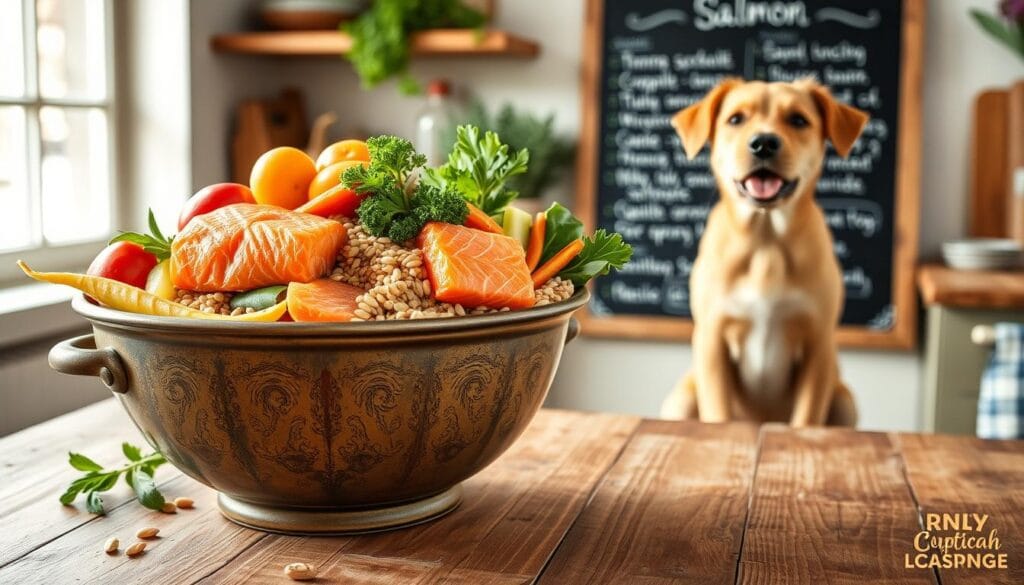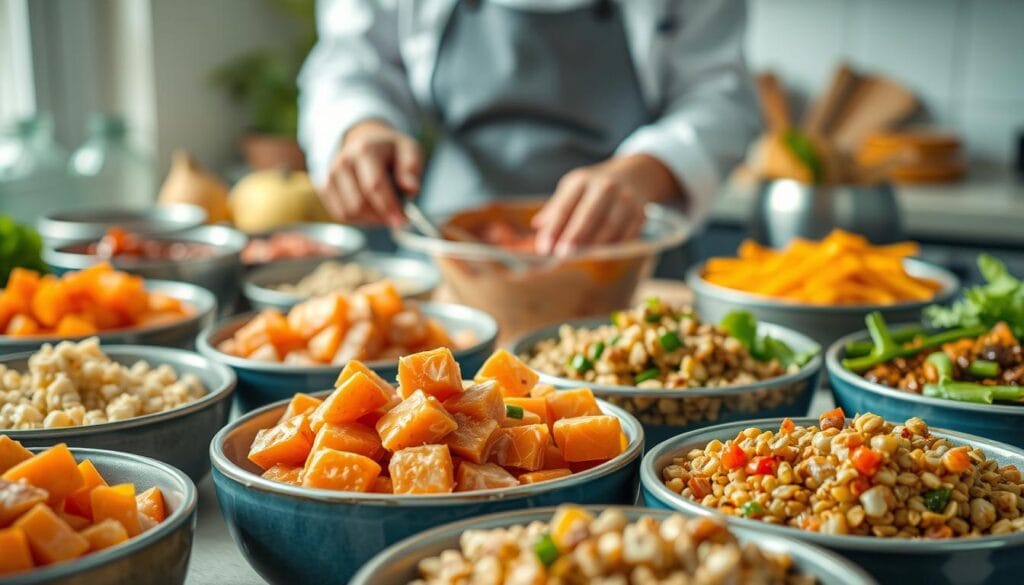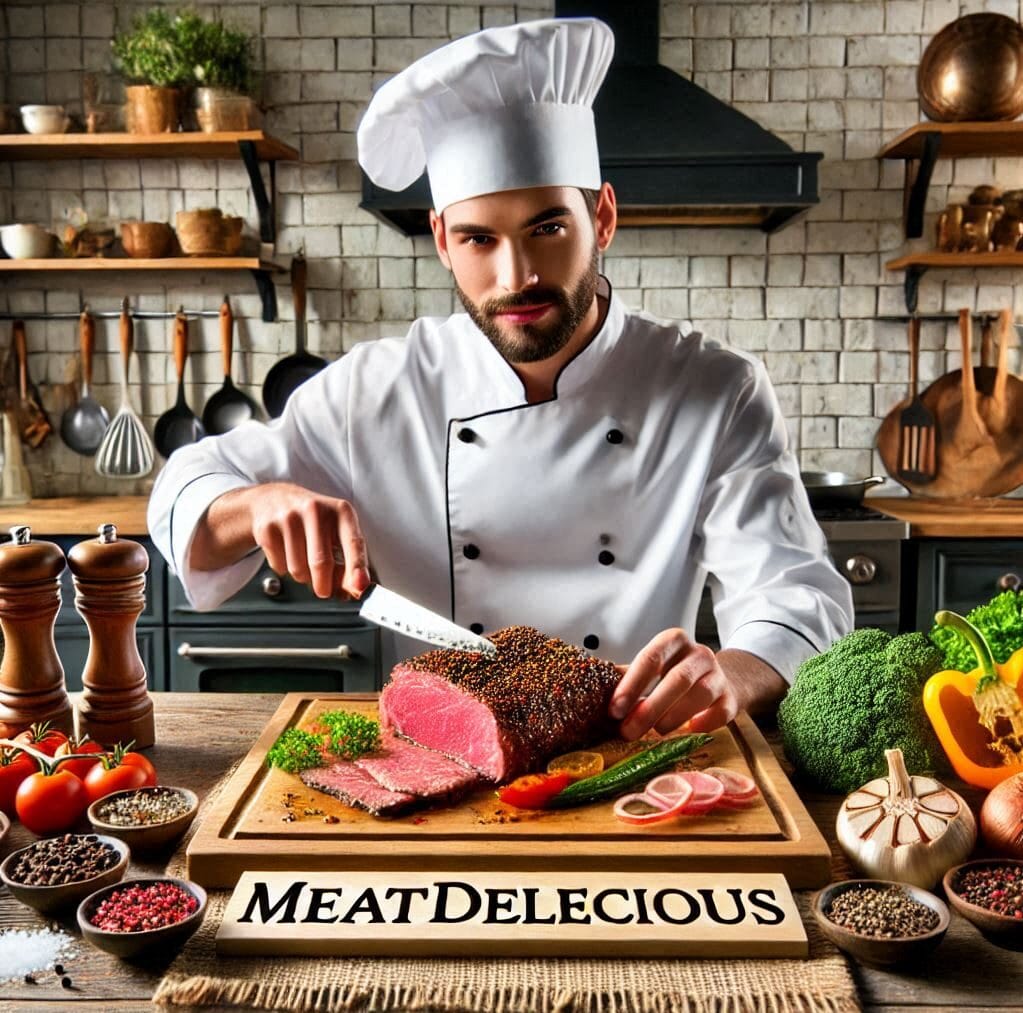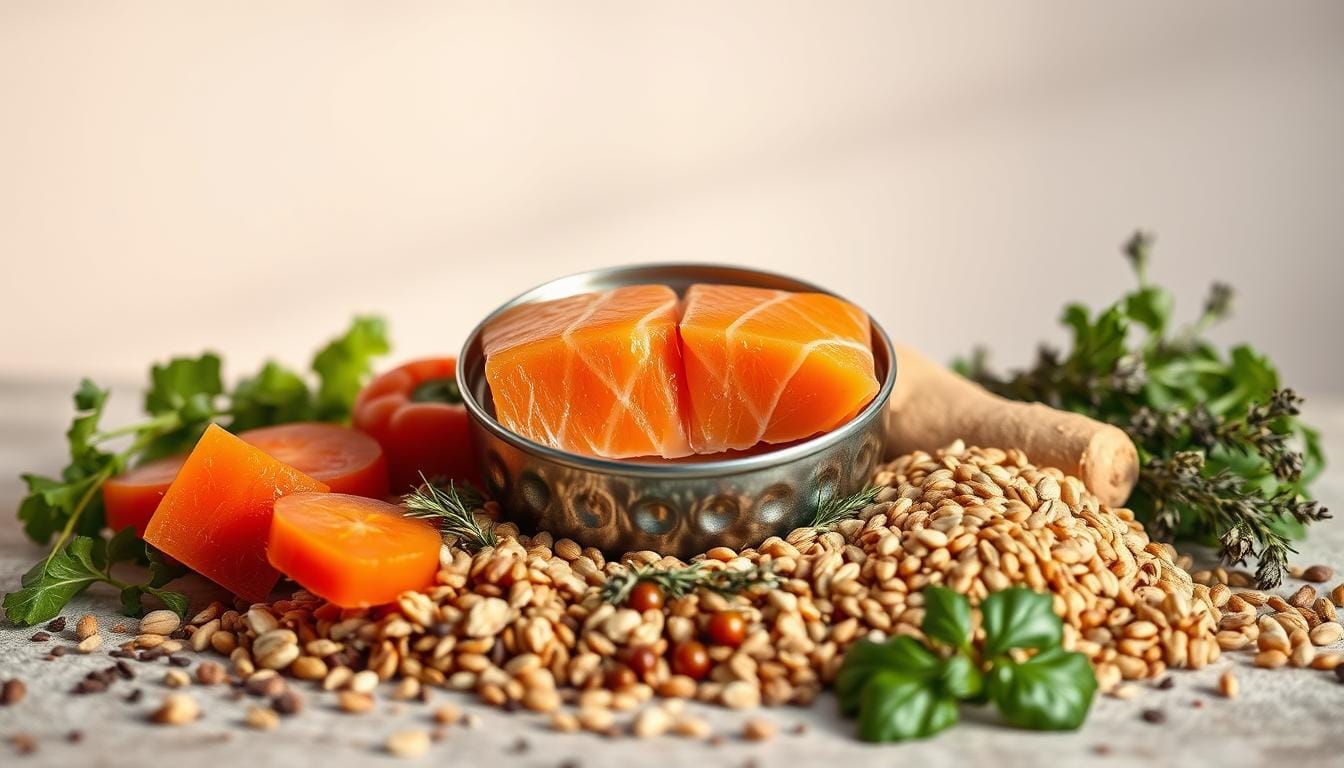Nutritious Dog Food Recipe Using Canned Salmon
As a pet owner, you want the best for your furry friend. Providing a balanced and healthy diet is one of the most important ways to ensure their well-being. Homemade meals allow you to take control of what your pet eats, ensuring they get the nutrients they need without any unnecessary additives.
Salmon is a great source of omega-3 fatty acids, which support your pet’s skin, coat, and overall health. This guide will walk you through a simple and nutritious recipe that combines high-quality protein with essential vitamins and fiber. Whether you’re looking to improve your pet’s diet or just want to try something new, this recipe is a fantastic option.
With easy-to-follow steps and practical tips for preparation and storage, you’ll find this guide both helpful and convenient. Let’s get started on creating a meal that your pet will love and benefit from!
Key Takeaways
- Salmon provides omega-3 fatty acids and essential nutrients for your pet’s health.
- Homemade meals give you full control over ingredients and quality.
- This recipe is simple to prepare and includes practical storage tips.
- Perfect for pet owners in the United States seeking healthy meal options.
- Supports skin, coat, and overall well-being with balanced nutrition.
Introduction to Homemade Dog Food
Crafting meals for your pet at home can be a rewarding experience. Not only does it allow you to control the quality of ingredients, but it also ensures your pet receives the essential nutrients they need for a healthy life.
Understanding the Benefits for Your Pet
Homemade meals can significantly improve your pet’s overall health. By using fresh, whole ingredients, you can enhance digestion and nutrient absorption. For example, omega-3 fatty acids found in salmon support skin and coat health, while fiber from pumpkin aids in digestion.
Customization is another advantage. You can tailor meals to address specific dietary needs, such as allergies or weight management. This flexibility ensures your pet gets the right balance of protein, vitamins, and minerals.
Overview of the Recipe’s Simplicity
This recipe is designed to be straightforward and uses easily accessible ingredients. Items like spinach, pumpkin, and brown rice are not only nutritious but also simple to prepare. Here’s a quick breakdown of the key components:
| Ingredient | Benefit |
|---|---|
| Salmon | Rich in omega-3 fatty acids |
| Pumpkin | High in fiber for digestion |
| Spinach | Packed with vitamins and minerals |
By preparing meals at home, you eliminate questionable additives found in some commercial options. This ensures your pet enjoys a natural and wholesome diet. Stay tuned for the step-by-step guide to creating this nutritious meal!
Why Opt for a Homemade Diet?
Taking charge of your pet’s nutrition can lead to a healthier, happier life for them. A homemade diet offers unmatched flexibility and control over what your pet consumes. This approach ensures they receive the best quality ingredients tailored to their specific needs.
Control Over Ingredients and Nutrients
When you prepare meals at home, you have complete control over every ingredient. This means you can avoid fillers, additives, and low-quality components often found in commercial options. You can also ensure your pet gets the right balance of nutrients, such as protein, vitamins, and healthy fats.
For example, using fresh vegetables like spinach and pumpkin provides essential fiber and vitamins. Whole grains like brown rice offer sustained energy. Knowing the source of each component assures you of its quality and safety.
Customization for Your Pet’s Specific Needs
One of the greatest advantages of a homemade diet is the ability to customize meals. If your pet has allergies or sensitivities, you can easily substitute ingredients. For instance, swapping out grains for sweet potatoes can help pets with grain intolerances.
You can also adjust portion sizes and nutrient levels based on your pet’s age, weight, and activity level. This customization ensures they receive the exact nutrition they need to thrive.
| Benefit | Example |
|---|---|
| Ingredient Control | Choose organic or locally sourced items |
| Nutrient Balance | Adjust protein, fat, and fiber levels |
| Allergy Management | Substitute ingredients to avoid triggers |
By opting for a homemade diet, you’re not just feeding your pet—you’re investing in their long-term health and happiness. It’s a great way to show them how much you care.
The Health Benefits of Salmon for Dogs
Salmon is a powerhouse of nutrients that can significantly enhance your pet’s health. Packed with essential vitamins, minerals, and healthy fats, it’s a great addition to any homemade meal plan. This nutrient-rich fish supports everything from skin and coat health to joint function and overall vitality.
Rich Omega-3 Fatty Acids and Protein
Salmon is an excellent source of omega-3 fatty acids, particularly EPA and DHA. These healthy fats help reduce inflammation, support brain function, and promote a shiny coat. Additionally, salmon provides high-quality protein, which is essential for muscle development and joint integrity.
For pets with allergies or sensitive skin, omega-3s can be a game-changer. They help manage skin conditions and improve hydration, leaving your pet’s coat soft and healthy.
Support for Skin, Coat, and Joint Health
The nutrients in salmon go beyond just omega-3s. It’s also rich in vitamin D, which supports strong bones and teeth. B vitamins found in salmon aid in energy metabolism, keeping your pet active and vibrant.
Joint health is another area where salmon shines. The anti-inflammatory properties of omega-3s can help ease stiffness and improve mobility, especially in older pets.
When preparing salmon, always ensure it’s cooked thoroughly to eliminate any risks. Canned salmon is a convenient option, but choose varieties packed in water without added oils or salt for the best results.
Essential Ingredients for a Balanced Meal
Creating a balanced meal for your furry companion starts with the right ingredients. A mix of vegetables, grains, and healthy fats ensures your pet gets the nutrients they need to thrive. Each component plays a vital role in supporting their overall health and well-being.
Vegetables, Grains, and Healthy Fats
Vegetables like spinach and carrots are packed with vitamins and antioxidants. Spinach, for example, is rich in iron and vitamin K, which support bone health. Carrots provide beta-carotene, promoting good vision and a strong immune system.
Grains such as brown rice and sweet potatoes offer sustained energy and fiber. Brown rice is easy to digest, while sweet potatoes are a great source of complex carbohydrates. These ingredients help maintain stable energy levels throughout the day.
Healthy fats, like coconut oil, are essential for maintaining energy and supporting skin health. They also aid in the absorption of fat-soluble vitamins, ensuring your pet gets the most out of their meal.
Key Vitamins and Minerals in Each Component
Pumpkin is a standout ingredient, offering both fiber and moisture. It aids digestion and helps keep your pet’s system running smoothly. Egg whites are another excellent addition, providing high-quality protein without extra fat.
Potatoes, when cooked properly, are a good source of potassium and vitamin C. These nutrients support muscle function and immune health. Combining these ingredients creates a meal that’s both nutritious and delicious.
Here’s a quick breakdown of the benefits of each key component:
| Ingredient | Benefit |
|---|---|
| Spinach | Rich in iron and vitamin K |
| Pumpkin | High in fiber for digestion |
| Coconut Oil | Supports skin and energy levels |
By carefully selecting and combining these ingredients, you can create a meal that meets your pet’s daily nutrient requirements. It’s a simple yet effective way to ensure they stay healthy and happy.
Preparation and Cooking Tools You’ll Need
Having the right tools in your kitchen makes preparing meals easier and more efficient. Whether you’re a seasoned cook or just starting, the right equipment ensures your ingredients are handled properly and cooked evenly.
Choosing the Right Pot and Utensils
A heavy-bottomed pot or Dutch oven is essential for even heat distribution. This prevents burning and ensures your ingredients cook thoroughly. Non-stick pans are also a great option for easy cleanup.
Accurate measuring tools, like a cup and minute timer, help maintain consistency. Proper measurements ensure the right balance of nutrients, such as protein and fiber, in every serving.
For storage, consider half-pint containers. These keep meals fresh and make portioning simple. Proper storage solutions also contribute to food safety, ensuring your pet’s meals stay healthy and delicious.
Setting up your kitchen before starting the recipe streamlines the process. Having everything within reach saves time and makes cooking more enjoyable. With the right tools, you’ll create nutritious meals with ease.
Step-by-Step Guide to Creating a Dog Food Recipe with Canned Salmon
Preparing a nutritious meal for your companion doesn’t have to be complicated. With a few simple steps, you can create a balanced dish that’s both healthy and delicious. Let’s dive into the process.
Preparing and Measuring Ingredients
Start by gathering all the necessary items. Dice one potato into small cubes for even cooking. Grate a carrot to add natural sweetness and essential vitamins. Measure out a cup of pumpkin purée for fiber and moisture.
Ensure the salmon is bone-free and fully cooked. If using canned salmon, drain it thoroughly. Have a minute timer ready to track cooking times accurately.

Detailed Cooking Instructions
Begin by simmering the diced potatoes in water for 8-10 minutes. This softens them while retaining their texture. Once tender, drain and set aside.
In a pan, add the grated carrot and a teaspoon of coconut oil. Sauté for 2-3 minutes to enhance flavor. Next, break up the egg whites into the pan, cooking until they’re fully set.
Add the spinach and salmon to the mixture. Stir gently to combine all ingredients. Finally, fold in the pumpkin purée to create a smooth, cohesive blend.
Let the dish cool before serving. This ensures it’s safe and ready for your companion to enjoy. Store leftovers in the fridge for up to three days or freeze for longer shelf life.
Safety Tips and Veterinary Recommendations
Ensuring your pet’s safety starts with proper food preparation and expert advice. A healthy diet is only as good as the care you take in preparing it. Consulting your veterinarian before making any dietary changes is essential to avoid potential health risks.
Ensuring Proper Cooking and Food Safety
Thoroughly cooking ingredients like salmon is crucial. Undercooked food can lead to digestive issues or even illness. Always remove bones to prevent choking hazards or intestinal blockages.
Gradual transitions to new meals help your pet adjust without discomfort. Start by mixing small amounts of the new recipe with their current food. Monitor for any signs of gastrointestinal changes, such as vomiting or diarrhea.
“A gradual introduction of new foods allows your pet’s digestive system to adapt smoothly, reducing the risk of upset.”
Food safety is equally important. Use clean utensils and surfaces to avoid contamination. Store meals in airtight containers and refrigerate or freeze them promptly to maintain freshness.
Key Safety Tips for Homemade Meals
Here’s a quick guide to ensure your pet’s meals are safe and nutritious:
| Tip | Benefit |
|---|---|
| Cook salmon thoroughly | Prevents bacterial contamination |
| Remove all bones | Avoids choking and blockages |
| Gradual diet transition | Reduces digestive upset |
| Proper storage | Maintains freshness and safety |
By following these guidelines, you can create meals that are not only nutritious but also safe for your companion. Always prioritize their health and consult your vet for personalized advice.
Exploring Recipe Variations for Your Dog
Experimenting with different ingredients can keep meals exciting and nutritious for your pet. By making simple swaps, you can tailor the recipe to their preferences while ensuring they get the nutrients they need. Variety also helps prevent boredom and keeps them looking forward to mealtime.

Substituting Ingredients for Different Tastes
If your pet isn’t a fan of salmon, try using ground turkey or chicken as an alternative. These proteins are equally rich in nutrients and can be a great change for their palate. For a vegetarian option, consider adding lentils or chickpeas for plant-based protein.
Vegetables like green beans or broccoli can replace spinach for added variety. These options provide different vitamins and minerals, enhancing the overall nutritional profile. Always ensure the vegetables are cooked and chopped for easy digestion.
Incorporating Additional Nutrients
Adding pumpkin or sweet potatoes can boost fiber content, aiding in digestion. Blueberries are another excellent addition, offering antioxidants and a touch of natural sweetness. These small changes can make a big difference in your pet’s health.
For an extra nutrient boost, consider mixing in a teaspoon of coconut oil. It supports skin health and provides a source of healthy fats. Always introduce new ingredients gradually to monitor your pet’s reaction.
Testing small batches is a smart way to determine what your pet enjoys most. This approach ensures they receive a balanced diet while keeping mealtime exciting and tailored to their needs.
Storage, Serving, and Transitioning Tips
Proper storage and serving techniques are essential for maintaining the quality of homemade meals. By following these guidelines, you can ensure your pet enjoys fresh, nutritious dishes every time.
Effective Storage Methods and Shelf Life
To keep meals fresh, store them in airtight containers. Refrigerate leftovers for up to three days or freeze them for longer shelf life. Label containers with the date to track freshness and avoid spoilage.
Portioning meals in advance simplifies serving. Use half-pint containers for easy measurements. This approach helps maintain nutritional quality and prevents waste.
How to Transition Your Pet to a Homemade Diet
Switching from commercial to homemade meals should be gradual. Start by mixing 25% of the new recipe with 75% of their current food. Over the next week, increase the homemade portion while reducing the old one.
Monitor your pet’s reaction during the transition. Look for signs of digestive upset, such as vomiting or diarrhea. If issues arise, slow the process and consult your veterinarian.
Maintaining a consistent feeding schedule helps stabilize their digestive system. Serve meals at the same time each day to create a routine. This consistency supports their overall health and well-being.
Conclusion
A homemade approach to pet meals ensures quality and balance in every bite. By preparing dishes yourself, you gain control over ingredients and provide nutrient-rich options tailored to your pet’s needs. From selecting fresh items like spinach and pumpkin to cooking with care, every step contributes to their well-being.
Salmon, rich in omega-3s, supports skin, coat, and joint health. Pair it with wholesome grains and vegetables for a complete, balanced meal. Experiment with variations to keep meals exciting and adapt to your pet’s preferences.
Always consult your veterinarian before making dietary changes and transition gradually to avoid digestive issues. Share your success with other pet owners to inspire healthier choices.
With a little effort, you can create meals that improve your pet’s health and happiness. Start today and see the difference a homemade diet can make!

